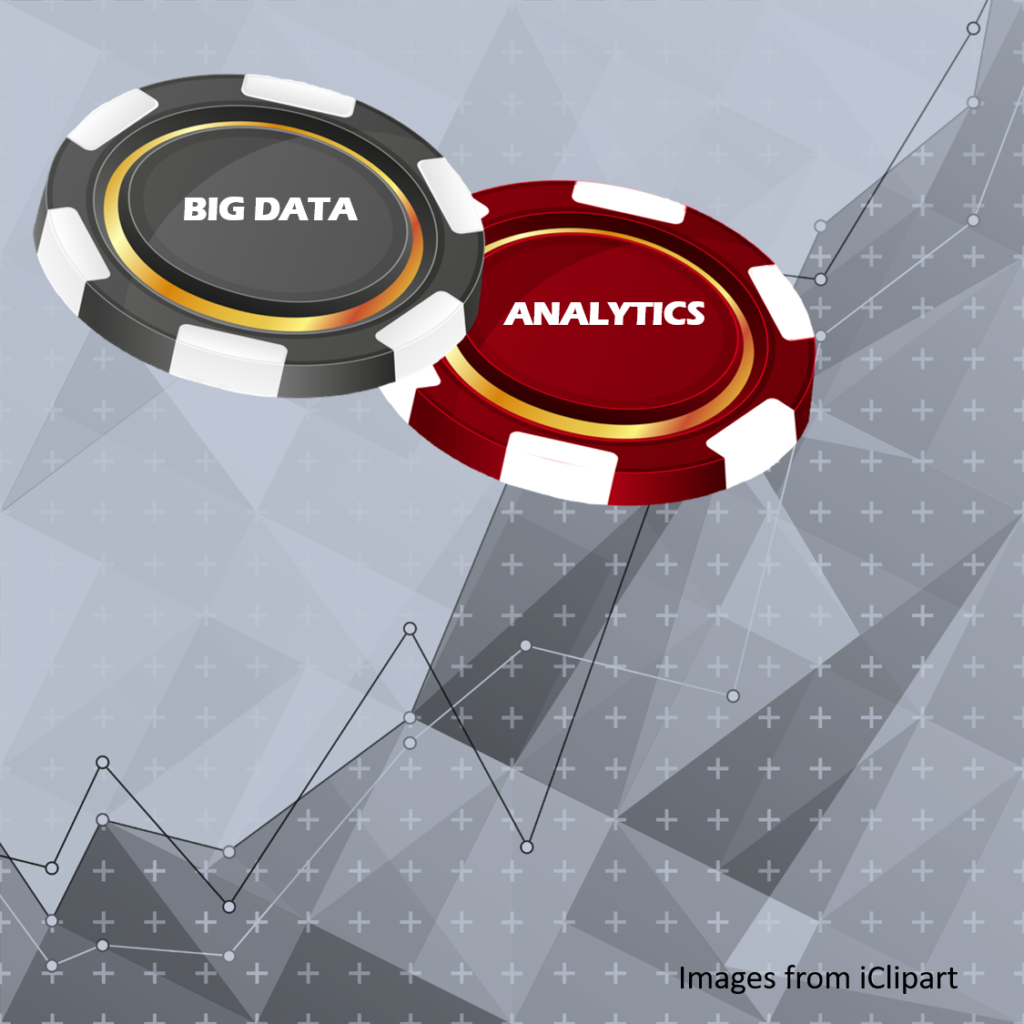Companies are always looking for a competitive edge and many organizations believe Big Data and advanced analytics can help them find one. The truth of the matter is so many organizations are now leveraging Big Data and advanced analytics that finding an edge is becoming increasingly difficult. Sam Ransbotham (@Ransbotham), David Kiron (@DavidKiron1), and Pamela Kirk Prentice (@pamelakprentice) assert, “Competitive advantage with analytics is waning. The percentage of companies that report obtaining a competitive advantage with analytics has declined significantly. … Increased market adoption of analytics levels the playing field and makes it more difficult for companies to keep their edge.”[1] You could say, advanced analytics is the ante to get into today’s business game.
Getting in the game
Companies not taking advantage of advanced analytics are falling behind their competition and the gap will continue to grow if they fail to act. James Manyika, director of the McKinsey Global Institute, insists it’s not too late to get started. “Some companies are gaining a competitive edge with their use of data and analytics,” he writes, “which can enable faster and larger-scale evidence-based decision making, insight generation, and process optimization. But there is room to catch up and to excel.”[2] The importance of making better decisions cannot be over-stressed. Bain analysts, Michael C. Mankins and Lori Sherer (@lorisherer), note that decision making is one of the most important aspects of any business. “The best way to understand any company’s operations,” they write, “is to view them as a series of decisions.”[3] They add, “Companies that make better decisions, make them faster and execute them more effectively than rivals nearly always turn in better financial performance. Not surprisingly, companies that employ advanced analytics to improve decision making and execution have the results to show for it.”
Getting in the game is obviously important; but, as Manyika points out, data and analytics not only get you into the game they can change the game. He explains, “Leading companies are using their [data and analytics] capabilities not only to improve their core operations but also to launch entirely new business models.” To get the most out of their data, companies often need to change the culture surrounding data collection and analysis. Digital futurist Chunka Mui (@ChunkaMui) explains, “Making wise decisions requires much better collaboration between functions that typically operate as silos. For example, market researchers, data scientists, and other information providers … cannot just be data collectors. They need to find out what needs to be known, then go out and get it.”[4]
Staying in the game
Data collection is obviously the starting point for developing a competitive analytics game plan. Data, however, comes in many forms that must integrated so it can be analyzed. Cognitive computing platforms can help with both the gathering and integrating of data — be it structured or unstructured. As Mui explains, integrated data is important because users from throughout the organization need access to it and the insights that can be gained from it. And they need those insights delivered in an understandable way. Mui writes, “[Analysis needs to be delivered in] a form that is usable by the people who make the decisions. Decision makers can’t just accept data or analytics without a cohesive plan. They must think about how and where the information they use comes from. Success requires understanding the interactions of all activities that affect those decisions, from initial data collection to the decision to do or not do something to what it takes to carry out that decision — and everything in between.”
Because most cognitive computing platforms employ natural language processing, users are able to interact with those platforms in useful ways without having to be data scientists. Bill Franks (@billfranksga), Chief Analytics Officer for The International Institute for Analytics, explains, “Many people don’t (and shouldn’t!) understand analytics at all. There are absolutely people within an organization who must understand how analytics work. … However, in most cases, it is still a relatively small number as a percentage of all employees.”[5] However, he adds a significant caveat to his observation. Most employees don’t need to be data scientists, BUT they do need to understand how analytics can improve their job performance. Manyika suggests effective data and analytics game plans have four components. They are:
- “Asking fundamental questions to shape the strategic vision: What will data and analytics be used for? How will the insights drive value? Which data sets are most useful for the insights needed?”
- “Solving for the problems in the way data is generated, collected, and organized. Many incumbents struggle to switch from legacy data systems to a more nimble and flexible architecture that can get the most out of big data and analytics. They may also need to digitize their operations more fully in order to capture more data from their customer interactions, supply chains, equipment, and internal processes.”
- “Acquiring the skills needed to derive insights from data; organizations may choose to add in-house capabilities or outsource to specialists.”
- “Changing business processes to incorporate data insights into the actual workflow. This is a common stumbling block. It requires getting the right data insights into the hands of decision makers — and making sure that these executives and mid-level managers understand how to use data-driven insights.”
Staying the game is not easy. Ransbotham and his colleagues explain, “The reality is that many companies still struggle to figure out how to use analytics to take advantage of their data. The experience of managers grappling, sometimes unsuccessfully, with ever-increasing amounts of data and sophisticated analytics is often more the rule than the exception. In many respects, the hype surrounding the promise of analytics glosses over the hard work necessary to fulfill that promise. It is hard work to understand what data a company has, to monitor the many processes necessary to make data sufficient (accurate, timely, complete, accessible, reliable, consistent, relevant, and detailed), and to improve managers’ ability to use data. This unsexy side of analytics is where companies need to excel in order to maximize the value of their analytics initiatives, but it is also where many such efforts stall.”
Summary
Organizations can no longer sit on the sidelines waiting for the right time to enter the data and analytics game. Competitors are already in the game making big, profitable bets based on the insights they are obtaining. In today’s business game, data and analytics are both the ante and the jackpot.
Footnotes
[1] Sam Ransbotham, David Kiron, and Pamela Kirk Prentice, “Beyond the Hype: The Hard Work Behind Analytics Success,” MIT Sloan Management Review, 8 March 2016.
[2] James Manyika with Michael Chui, Anu Madgavkar, and Susan Lund, “What’s now and next in analytics, AI, and automation,” McKinsey & Company, May 2017.
[3] Michael C. Mankins and Lori Sherer, “Creating value through advanced analytics,” Bain Brief, 11 February 2015.
[4] Chunka Mui, “Are You Making The Leap From Big Data To Wise Decision Making? (Part 1 Of 2),” Forbes, 9 October 2017.
[5] Bill Franks, “No, Not Everyone Needs To Understand Analytics,” International Institute for Analytics, 12 October 2017.





